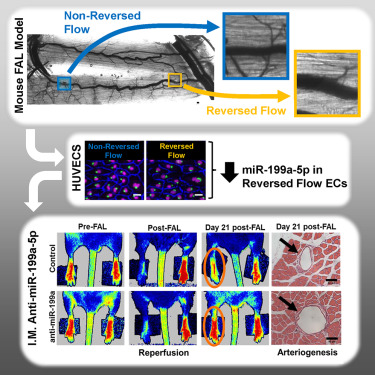Molecular Therapy - Nucleic Acids ( IF 6.5 ) Pub Date : 2018-08-08 , DOI: 10.1016/j.omtn.2018.08.001 Joshua L Heuslein 1 , Catherine M Gorick 2 , Stephanie P McDonnell 3 , Ji Song 2 , Brian H Annex 3 , Richard J Price 1

|
Arteriogenesis, the growth of endogenous collateral arteries bypassing arterial occlusion(s), is a fundamental shear stress-induced adaptation with implications for treating peripheral arterial disease (PAD). Nonetheless, endothelial mechano-signaling during arteriogenesis is incompletely understood. Here we tested the hypothesis that a mechanosensitive microRNA, miR-199a-5p, regulates perfusion recovery and collateral arteriogenesis following femoral arterial ligation (FAL) via control of monocyte recruitment and pro-arteriogenic gene expression. We have previously shown that collateral artery segments exhibit distinctly amplified arteriogenesis if they are exposed to reversed flow following FAL in the mouse. We performed a genome-wide analysis of endothelial cells exposed to a biomimetic reversed flow waveform. From this analysis, we identified mechanosensitive miR-199a-5p as a novel candidate regulator of collateral arteriogenesis. In vitro, miR-199a-5p inhibited pro-arteriogenic gene expression (IKKβ, Cav1) and monocyte adhesion to endothelium. In vivo, following FAL in mice, miR-199a-5p overexpression impaired foot perfusion and arteriogenesis. In contrast, a single intramuscular anti-miR-199a-5p injection elicited a robust therapeutic response, including complete foot perfusion recovery, markedly augmented arteriogenesis (>3.4-fold increase in segment conductance), and improved gastrocnemius tissue composition. Finally, we found plasma miR-199a-5p to be elevated in human PAD patients with intermittent claudication compared to a risk factor control population. Through our transformative analysis of endothelial mechano-signaling in response to a biomimetic amplified arteriogenesis flow waveform, we have identified miR-199a-5p as both a potent regulator of arteriogenesis and a putative target for treating PAD.
中文翻译:

内皮细胞暴露于仿生流动波形可确定miR-199a-5p作为动脉生成的有效调节剂。
动脉生成是绕过动脉闭塞的内源性侧支动脉的生长,是一种基本的切变应力诱导的适应性疾病,对治疗外周动脉疾病(PAD)具有重要意义。然而,动脉生成过程中的内皮机械信号尚不完全清楚。在这里,我们测试了一种假设,即机械敏感性microRNA miR-199a-5p通过控制单核细胞募集和促动脉生成前基因表达来调节股动脉结扎(FAL)后的灌注恢复和侧支动脉生成。先前我们已经表明,如果在FAL后小鼠侧支动脉段暴露于FAL后的逆向流动,则它们会显着放大动脉生成。我们对暴露于仿生反向流动波形的内皮细胞进行了全基因组分析。根据此分析,在体外,miR-199a-5p抑制了促动脉生成基因的表达(IKKβ,Cav1)和单核细胞与内皮细胞的粘附。体内在小鼠中进行FAL后,miR-199a-5p过表达会损害足部灌注和动脉生成。相反,单次肌内抗miR-199a-5p注射引起强烈的治疗反应,包括完全的足部灌注恢复,明显的动脉生成增强(节段电导增加> 3.4倍)和改善的腓肠肌组织组成。最后,我们发现与危险因素对照组相比,间歇性lau行的人PAD患者血浆miR-199a-5p升高。通过我们对仿生放大的动脉生成流波形做出响应的内皮机械信号的转化分析,我们已确定miR-199a-5p既是动脉生成的有效调节剂,也是治疗PAD的公认靶点。











































 京公网安备 11010802027423号
京公网安备 11010802027423号